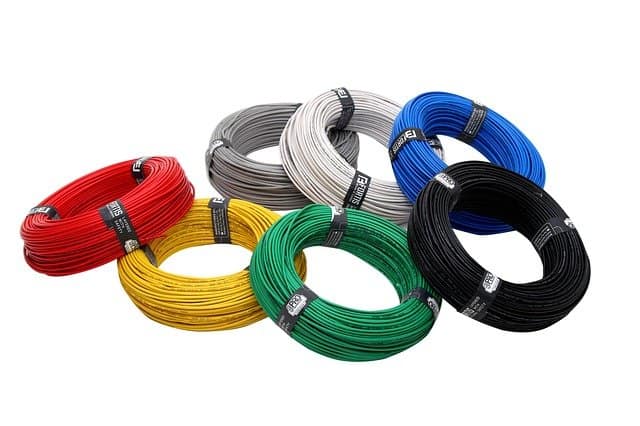Landscape wiring is quickly gaining popularity and becoming a favorite project with home-owners.
It brings value to the home and street, adds a security element, and definitely brings a lovely ambiance to the exterior.
Landscape wiring can be buried depending upon the rating it has. Direct burial rated cables are protected enough to be buried as it is. Other underground cables, while resistant to water and temperature, need to be in conduits or trunking for added protection.
What Kind Of Wires Can Be Buried Underground?
While technically you can run wiring right from your home’s 120-volt standard electricity supply, it’s not the best method.
You want to use a transformer to step down your 120V supply to the low-voltage 12V system of lights. This results in the safer and cheaper running.
Low-voltage wiring comes in a few different thickness levels, indicated by their code. Starting from 10-gauge being the thickest and 16-gauge being the thinnest.
Thicker wires can carry current over longer distances without your lights experiencing voltage drops, but they are expensive.
Most lighting kits in the market come packaged with 16-gauge wiring because it is cheap but unable to carry current more than 100 feet.
Ideally, if you need to install more than 20 LEDs in the future, 12-gauge works most suitably in many cases.
A 12-gauge can carry current up to 300 feet out without a voltage drop in your lights, where each bulb will likely be consuming 4-8 watts of power.
Some wiring is rated for ‘direct burial’ applications.
This rating means the wiring you buy can be directly buried into wet or dry ground, without the need for extra protection, sheathing, or piping.
This cable has a protective jacket that saves the wiring from moisture, sunlight, and fungus.
You do not require special conduits as long as (underground feeder) UF-listed direct burial cable is used.
How Deep You Can Bury Landscape Lighting?
While you can connect all your cables and lay them as it is on the ground, it is, of course, neither practical nor a pretty sight. So the best option is to properly bury the wiring.
A good rule of thumb is to dig about 6 inches deep into the mulch or soft soil and grassy areas. Digging an angled trench with a thin sharp spade allows quick digging and quick sealing of the trench.
Some countries have specific regulations on digging into the ground, the minimum depth, and subsequent wiring marking, such as the National Electrical Code (NEC) in the USA.
Get in touch with your local authorities to be sure.
Nevertheless, a 6-inch depth will allow the cable to be secure enough and not pulled out easily or cut into when digging for gardening, etc.
Also read: Does Outdoor Lighting Need GFCI?
Burying too deep will only add to labor and material cost without added benefits.
It is also essential to cover the trench back with soil packed as tightly as it was before. You can choose to add more soil and grass seeds to reinforce the loose ground.
If, for commercial uses, someone needs to install 120 voltage circuit cabling, then the burial codes are especially strict and need to be referred.
In this case, a depth of at least 18-24 inches is required. This can only be achieved by a commercial-grade trenching machine.
If in the US, it is highly recommended to call 811, the national “Call Before you Dig Hotline”, a few days before you dig. A city or utility representative will come to your property and mark any existing lines going through.
How To Protect Buried Wiring Against Rodents
Let’s be honest, rodents are not going anywhere. They chew and destroy wiring, causing millions of dollars of damage every year.
Thankfully, there are ways of protecting the wires from these losses.
Rodents, including mice, rats, and squirrels, can chew through rubber and soft plastic, among other materials. Even if the wire is buried, rodents bury inside the ground and can get to it.
If a small portion of your wire is chewed, the whole line needs to be replaced. So it’s essential to protect them adequately.
The best thing is to bury the wiring inside a protective conduit made of plastic or metal. The thickness of the conduit’s diameter needs to be more than one inch as rodents cannot open their mouths that wide.
And since mice can get inside spaces wider than ¼ inch, it becomes important to prevent access to the inside of the conduits from the ends.
Using steel wool, duct seal (Amazon), or insulating foam (Amazon) to seal the openings end could be effective.
Steel trunking is also effective at keeping rodents away, but you need to consider the costs.
Nevertheless, having an effective long-term solution will save your lights and wires from quickly becoming rodent nests!
Can Wet Ground Damage Buried Wiring?
Underground direct burial rated wiring is meant to withstand wet conditions. The multiple layers of thermoplastic sheathing and protective cabling prevent water from penetrating the conducting wires inside.
If there has been excessive rain or flooding that brings up your buried cables, it is advised to get it checked by an electrician. It may be that the floodwater contained other contaminants or pollutants that could erode the cable later.
Needless to say, only dry rated cabling, such as NM-B, buried with conduits need to be replaced in case of rain. They are not rated for wet conditions and can damage the wiring.
In fact, running power lines underground prevents them from damage from excessive rain and floods.
Related: Do Security Lights Need Planning Permission?
Does Low Voltage Wiring Need To Be In Conduit?
As you have seen above, having your low-voltage wires in conduits is better than having no conduits at all. The next step to see if you prefer plastic or metallic conduits.
If you are not using direct burial due to the added cost, conduits should be your plan B. They have the advantage of protecting the wires from rodents, weather, and from accidentally shoveling.
For landscape wiring, low-voltage wiring is the easiest and safest option. These wires should be covered with conduits; otherwise, they may erode or be chewed on.
Related: Does Outdoor Lighting Need To Be On A Separate Circuit?
Final Words
You should make sure to have a map of the path, depth, and type of wires you have laid out.
You may need it for yourself after a few years or show it to the electrician in case of any future work.
So go ahead and plan out your landscape lighting project with your new-found knowledge of burying lighting wires.
How do you plan to bury your landscape lighting wires?
Have you considered direct burial or conduits?
Share your ideas with me in the comments below.




